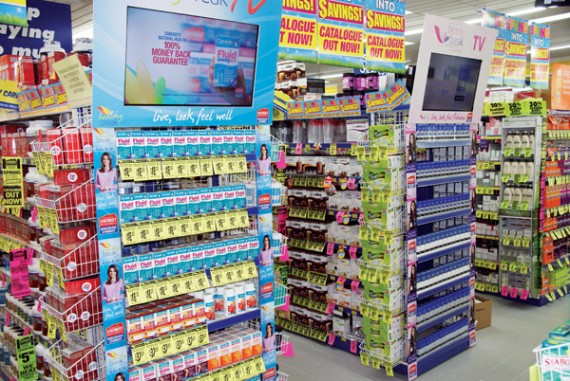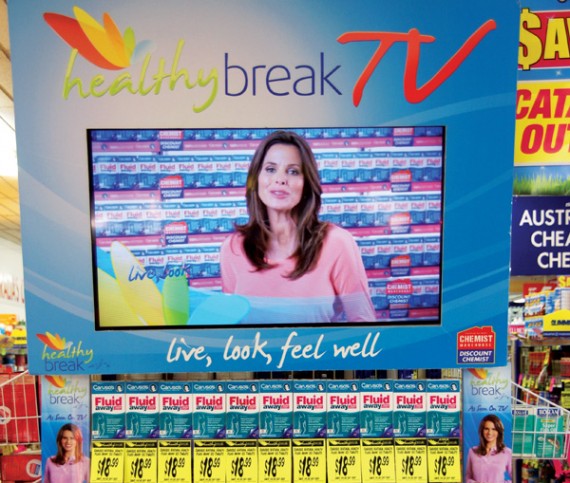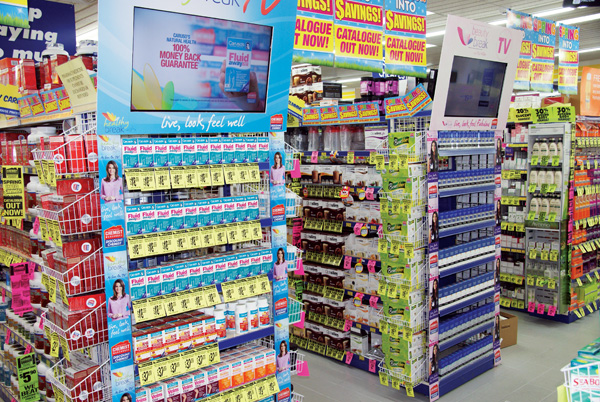
Chemist Warehouse adds signage to its omni channel marketing… all 300+ stores.
Chemist Warehouse is an Australian owned pharmacy which trades on offering great products, great prices and great service. With over 300 stores across Australia, Chemist Warehouse is continuously expanding and a clear market leader.
Chemist Warehouse’s marketing strategy is strong. It’s gone with an Omni Channel approach which provides great media opportunities for its stocked brands within its stores. For example, Chemist Warehouse and its brands are continuously advertised on all prime TV channels, all radio stations and every newspaper right throughout the year. On top of this they have an in-store radio station on which its brands take airtime, and have full perimeter advertising at AFL games. It has also established an ‘infomercial’-style brand through TV advertising called ‘Healthy Break’ and ‘Beauty Break’ using celebrities such as Jo Silvagni and Pia Miller.
TAKING IT INSIDE
Chemist Warehouse could see the possibility of doing something in their stores using video, and early in 2012 started looking at options. Specifically, Chemist Warehouse wanted to add to store ambience and energy, provide information to customers, increase sales of promoted items, support catalogue events and to sell airtime to stocked brands.
Digital signage was selected to achieve this. Chemist Warehouse wanted the ability to distribute video in store, provide proof of play to brands and to manage the content by their internal marketing team.
Ryan Calvert, Technical Specialist at Chemist Warehouse chose OneLAN as the signage platform for its stability (the software runs on Linux), along with the fact it is cost competitive, and enables either full screen or multi-zone multimedia layouts with simple content management.
brands advertising on the digital signage screens the return on investment (ROI) is such that slots are now fully booked through 2015
FOUR CHANNELS PER STORE
Chemist Warehouse elected to have four separate channels of content to each store: two purely for advertising support, complemented by ‘Healthy Break’ and ‘Beauty Break’ infomercials located in a prime position at the entrance to the store. Four wireless OneLAN media players and two 40-inch screens, and two 32-inch screen are installed in each store.
Unlike many in-store signage networks, Chemist Warehouse is seeing its displays as a bona fide revenue source — which makes for a compelling installation case. What’s more, the in-store network complements its omni channel marketing approach like the proverbial hand in glove. All up, you have an engaging message presented in an engaging way to an engaged audience who are either queuing or waiting to collect their prescription.
MANAGED IN HOUSE
Chemist Warehouse manages the network of players itself using resources the company already had in marketing and IT technical support. The design is easy to change and therefore powerful to its brands which may want more. For example, some advertisers can take over the whole screen for a particular ad, instead of occupying one zone.
The ability to offer advertising slots on the screens in-store is an exciting and powerful innovation for Chemist Warehouse. Sales growth was above expectation especially for the prime position infomercials which is the first item a customer sees when they enter a store. The success of this is such that Chemist Warehouse’s digital signage network rapidly became fully booked, and is now booked through 2015.
JUST THE MEDICINE
This is a hugely successful rollout and a 24-carat example of true omni channel marketing.
Chemist Warehouse can now engage with its customers in its 300 bricks and mortar stores, via radio, TV, in-store video, through a catalogue, banner ads or via its website and social media.
This is one of the largest deployments of retail digital signage in Australia. Which in the past hasn’t always been anything like a guarantee of success. But already, Chemist Warehouse’s initiative is putting runs on the board — not only is it effective as a marketing channel it’s generating revenue in and of itself.
VideoPro (OneLAN): videopro.co.nz or www.onelan.com

Digital Signage Masterclass: Chemist Warehouse
Ryan Calvert, Technical Specialist Business Systems at Chemist Warehouse, talks to DigitalSignage Editor, Chris Holder.
DS: What prompted the push into digital signage?
Ryan Calvert: We needed to extend the amount of advertising ‘space’ we could provide suppliers. Chemist Warehouse provides suppliers with the best chance of having their product purchased over another by inclusion in our marketing omni channel. We sell our TV and radio space, our magazine and newspaper space… we’re selling our in-store floor space; even the airspace with floating posters. Still, our suppliers were asking for more. Which led us to digital signage.
DS: What building blocks did you start with when embarking on the design of the signage?
RC: The main driver was our Healthy Break and Beauty Break infomercials. They were popular prior to our digital signage rollout and formed the basis of the rollout. If a supplier signs up to Healthy Break or Beauty Break they get full national radio/TV coverage and our stores will be reset to give that product prime position.
The idea is, the consumer has seen this product on TV, at an AFL match or on the internet; they’ve come into the store to buy it and they don’t have to look for it. It’s the first thing they see.
DS: Which accounts for the front position of those two screens. And that’s worked?
RC: We can’t keep the stock on the shelves. It just empties itself immediately. Naturally, news got out, and our suppliers can’t get enough of Healthy Break and Beauty Break. Within six weeks of going live nationally we’d sold those spaces one year in advance. In fact, I think the whole of 2015 is already sold.
DS: Does audio accompany Healthy Break and Beauty Break?
RC: Yes, but it’s not important. You need to be very close to the screen to hear it. We’re relying on people deciding to buy the product before they’ve entered the store. They’ve done their research, know how much it’ll cost… they just need to know where to find it.
DS: That accounts for two of the four in-store channels. Can you talk us through the dispensary channel?
RC: We use that screen to market ‘S2’ items — which is pharmacy speak for products you can only buy over the counter. That display hosts our Dispensary TV which carries video of S2 product which at this time of year would be a cold and flu tablet, and in Spring might turn into allergy treatments and so on. That third TV in the dispensary has a few zones: it has an RSS feed down the bottom, video on the left, our catalogue tiles on the right, and our logo at the top. When you buy the space, the supplier can take over that screen with an ad for two weeks. Every five minutes it will take over that screen and play that advertisement.
It’s a prime position because people are waiting for their prescriptions and are happy to be diverted by the news headlines, weather and be exposed to the advertising.
DS: And the fourth channel?
RC: The fourth is our more generic cashier TV. That was put there due to the lines building up in our stores and can influence those last-minute decisions. In the digital signage mix, it’s more for the benefit of the customer and less for the supplier. But it does complement the whole solution and is a key touchpoint.
DS: What were the main criteria for choosing the digital signage platform?
RC: We needed central management and central reporting. Most platforms don’t. Other that do, were unnecessarily complicated — requiring training at head office. Part of the objective was to find a platform that was easy to pick up and familiar. We wanted to keep digital signage in the marketing department, which relies on Adobe’s Creative Suite. So we found that OneLAN was very similar in the back end to Photoshop, when it comes to layers. It was easy for them to grasp it and embrace it.
If we’d not taken that approach then it would have been seen as just another extra task. But maintaing the signage in OneLAN is easy and our guys/gals can see the results. The more time they spend in managing the digital signage the more successful it will be.
DS: Traditionally, digital signage can’t find a friend in any department. How did you get the project adopted within the Chemist Warehouse structures?
RC: Ideally, I want our web developers and web marketing (which is separate to our print/TV marketing department) to own it. For now, they don’t want a piece of it. Ideally, from an IT perspective, I wanted a digital signage platform that would integrate with our SQL and then also display html5 — to future proof it and provide options.
Obviously, I’ve not got exactly what I want. But for now, to make it easy, we’re using jpeg tiles that our marketing department already have for their catalogues and newspaper ads, and are easy to resize to work in the digital signage.
Naturally, our IT department hated managing the solution. So, recently, we’ve outsourced the signage network management to get over that hurdle.
You’re right, people don’t want to own it. But thankfully OneLAN made it easier for digital signage to be adopted by our existing departments.
We’ll end up converting all our players to html5. Why? When a new catalogue comes out all our stores’ look and feel reflect that new catalogue — it’s a key reason why Chemist Warehouse doesn’t simply feel like we’ve got a year-round sale on. Currently our digital signage doesn’t change. But with html5 we could have the digital signage change in keeping with the website.
DS: What’s next?
RC: We’re exploring the possible of running front window digital signage to capture foot traffic. We spend a lot of money changing our front windows each week and we’re looking into whether it would be more cost effective to use a screen. We’ve just set up an 80-inch high-nit LCD for our board to review. As it stands, it’s quite pricey but we’ll keep any eye on that space.

